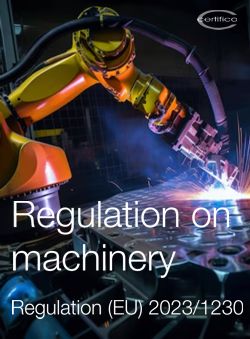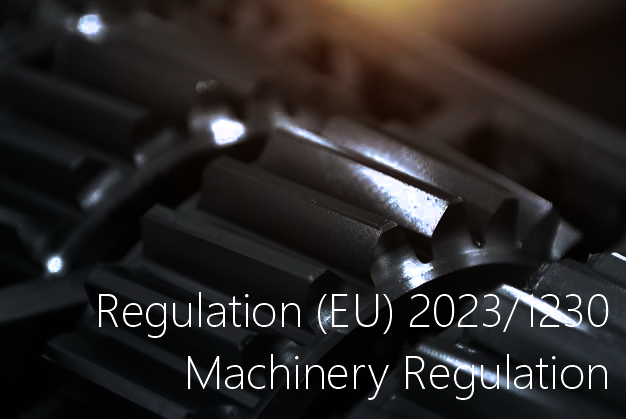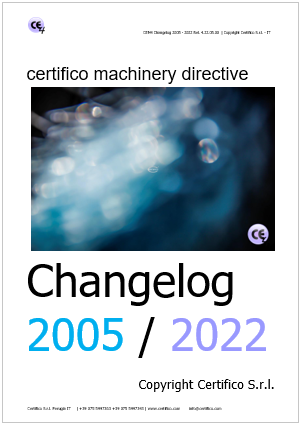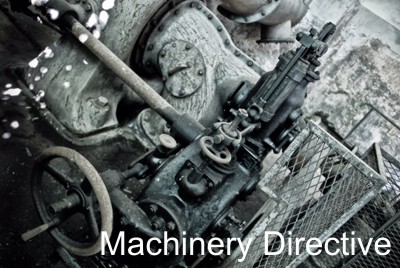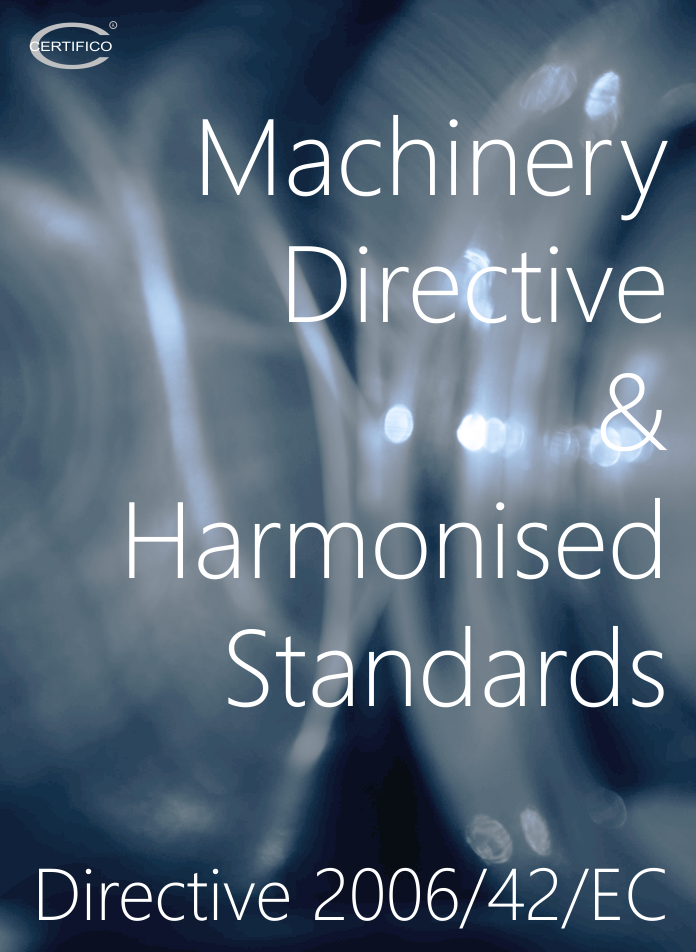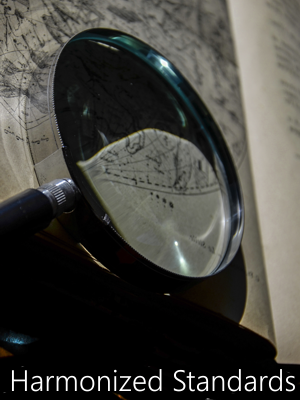Posted in News
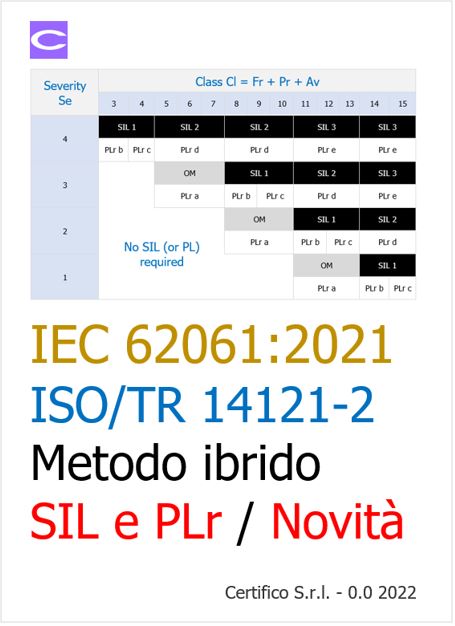
EN IEC 62061:2021 | ISO/TR 14121-2 Metodo ibrido SIL e PLr / Novità
ID 16004 | 09.03.2022 / Documento allegato
Documento sulla corretta modalità per determinare il SIL richiesto (o il PLr) , in accordo con la nuova norma EN IEC 62061:2021 (CEI 2022) in relazione con l'applicazione del metodo ibrido (rif. cap. 6.5 ISO/TR 14121-2 “Strumento ibrido”) nella Valutazione dei rischi macchine.
A febbraio 2021 è stata pubblicata la nuova edizione della norma EN IEC 62061 ma non si tratta di un semplice aggiornamento della Norma esistente. Con la nuova edizione la norma non si applica più solo ai sistemi di comando elettrici ma può essere applicata anche per tutti i tipi di tecnologie, ad esempio per sistemi pneumatici o idraulici.
Altre modifiche rispetto l’edizione precedente sono le seguenti:
- modifiche apportate al metodo per la definizione del livello SIL necessario;
- necessità di creare specifiche dei requisiti di sicurezza;
- possibilità di utilizzare dispositivi che sono stati sviluppati secondo altre norme;
- ulteriori informazioni dettagliate sul software applicativo relativo alla sicurezza.
La IEC 62061 tratta il grado di affidabilità richiesto per un sistema di controllo rilevante per la sicurezza: in questo caso, la stima si basa su un metodo ibrido, una combinazione tra una matrice e un approccio quantitativo.
Il metodo ibrido descritto nell’Allegato A della
EN IEC 62061:2021 è equivalente al metodo ibrido descritto al cap. 6.5 della
ISO/TR 14121-2.
La matrice della tabella A.6 della IEC 62061:2021 indica anche come determinare il PLr e ne illustra la relazione con il SIL necessario.
La EN IEC 62061:2021 tratta il grado di affidabilità richiesto per un sistema di controllo rilevante per la sicurezza: in questo caso, la stima si basa su un metodo ibrido, una combinazione tra una matrice e un approccio quantitativo.
La determinazione del SIL richiesto per un SSC si basa sulla matrice ibrida descritto nell’Allegato A della EN IEC 62061:2021 che è, in effetti, equivalente al metodo ibrido descritto al cap. 6.5 della ISO/TR 14121-2.
La matrice della tabella A.6 della EN IEC 62061:2021 riporta anche come determinare il PLr e ne illustra la relazione con il SIL necessario.
La EN IEC 62061:2021 tratta anche la validazione delle funzioni di sicurezza sulla base di metodi statistici e strutturali.
IEC 62061:2021 “Safety of machinery - Functional safety of safety-related control systems”
Data di pubblicazione: 2021-03
Recepita in Italia con la CEI EN IEC 62061:2022 “Sicurezza del macchinario - Sicurezza funzionale dei sistemi di comando e controllo relativi alla sicurezza”.
Data di pubblicazione IT: 2022-01
La norma non è stata ancora armonizzata per la Direttiva 2006/42/CE. L’edizione armonizzata è ancora la EN 62061:2005.
La Norma prescrive requisiti e fornisce raccomandazioni per la progettazione, l'integrazione e la convalida dei sistemi di controllo relativi alla sicurezza (SCS) per le macchine. È applicabile ai sistemi di controllo utilizzati, singolarmente o in combinazione, per svolgere funzioni di sicurezza su macchine non trasportabili manualmente durante il lavoro, compreso un gruppo di macchine che lavorano insieme in modo coordinato. La presente è una Norma specifica per il settore dei macchinari nell'ambito della serie di Norme CEI EN 61508 (tutte le parti). La progettazione di sottosistemi elettronici programmabili complessi o elementi di sottosistemi non rientra nell'ambito di questa Norma Questa Norma specifica i requisiti generali per la progettazione e la verifica di un sistema di controllo relativo alla sicurezza destinato ad essere utilizzato in modalità a domanda alta/continua La presente Norma affronta esclusivamente i requisiti di sicurezza funzionale volti a ridurre il rischio di situazioni pericolose e si applica ai rischi derivanti direttamente dai pericoli della macchina stessa o da un gruppo di macchine che lavorano insieme in modo coordinato.
La norma sostituisce completamente la Norma CEI EN 62061:2005-09, che rimane applicabile fino al 26-04-2024.
La norma EN IEC 62061:2021 in attesa di armonizzazione già contiene l’allegato ZZ che definisce la relazione tra la norma e la Direttiva 2006/42/CE (Presunzione di conformità).

Table ZZ.1 — Correspondence between this European standard and Annex 1 of Directive] 2006/42/EC [2006 OJ L 157]
EN ISO 13849-1:2015 “Safety of machinery - Safety-related parts of control systems - Part 1: General principles for design”
Data entrata in vigore: 23 dicembre 2015
Recepita in Italia con la UNI EN ISO 13849-1:2016 “Sicurezza del macchinario - Parti dei sistemi di comando legate alla sicurezza - Parte 1: Principi generali per la progettazione”.
Data entrata in vigore IT: 28 gennaio 2016
La norma fa parte delle norme armonizzate per la Direttiva 2006/42/CE sulle macchine.
La norma specifica i requisiti di sicurezza e le linee guida sui principi di progettazione e integrazione di parti dei sistemi di comando legate alla sicurezza, inclusa la progettazione del software.
ISO/TR 14121-2:2012 “Safety of machinery - Risk assessment - Part 2: Practical guidance and examples of methods
Data entrata in vigore: 31 maggio 2012
Recepita in Italia con la UNI ISO/TR 14121-2:2013 “Sicurezza del macchinario - Valutazione del rischio - Parte 2: Guida pratica ed esempi di metodi”
Data entrata in vigore IT: 13 giugno 2013
Il rapporto tecnico fornisce una guida pratica per l'esecuzione della valutazione del rischio per il macchinario in conformità alla UNI EN ISO 12100 e descrive diversi metodi e strumenti per ogni fase del processo. Fornisce esempi di differenti misure che possono essere utilizzate per ridurre il rischio ed è destinata ad essere utilizzata per la valutazione del rischio di una estesa varietà di macchinari in termini di complessità e di potenziale di danno. I suoi utilizzatori previsti sono le persone coinvolte nella progettazione, installazione o modifica del macchinario. L'appendice A fornisce uno specifico esempio di valutazione del rischio e processo di riduzione del rischio.
[...]
A.2.2 Risk estimation
Risk estimation should be carried out for each hazard by determining the risk parameters that as shown in Figure A.1 should be derived from the following:
- severity of harm, Se; and
- probability of occurrence of that harm, which is a function of:
-- frequency and duration of the exposure of persons to the hazard, Fr;
-- probability of occurrence of a hazardous event, Pr; and
-- possibilities to avoid or limit the harm, Av.
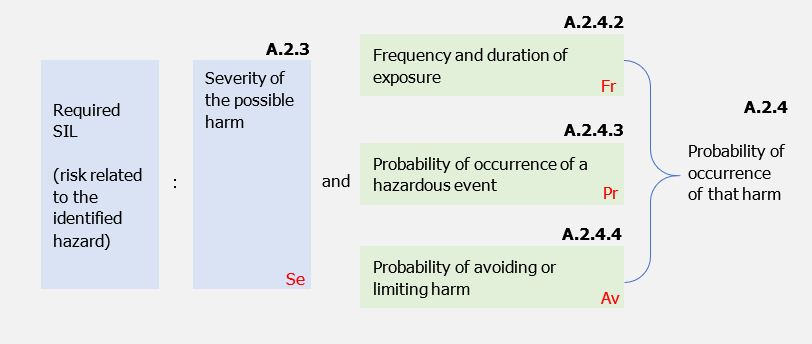
Figure A.1 - Parameters used in risk estimation
[...]
A.2.4.2 Frequency and duration of exposure
On determination of the exposure level of people to a hazard, according to 5.5.2.3.1 of ISO 12100:2010, the work situation should be assessed considering factors such as:
- the mode of operation during the access (setting/automatic/manual/special mode);
- nature of access (feeding of materials, correction of malfunction, maintenance or repair);
- time spent in the hazardous area;
- frequency of access to the hazardous area.
The parameter Fr is defined by frequency of presence of the people in the hazardous area and by the average duration of presence.
It should then be possible to estimate the interval between accesses to a hazardous area and therefore the frequency of the exposure to a potential hazard (referred to a period ≥ to one year).
This factor does not include consideration of the failure of the SCS. Select the appropriate row for frequency and duration of exposure (Fr) of Table A.2. Insert the appropriate number under the Fr column in Table A.5.

Table A.2 - Frequency and duration of exposure (Fr) classification
[...]
A.2.6 SIL assignment
Using Table A.6, where the severity (Se) row crosses the relevant column (Cl), the intersection point indicates whether action is required. The black area indicates the SIL assigned as the target for the SCS. The lighter shaded areas should be used as a recommendation that other measures (OM) be used.
Where function(s) have safety implications but application leads to a required safety integrity less than that required by SIL 1 (OM or No SIL), compliance with the requirements of IEC 60204-1 or other relevant standards can lead to an adequate performance of the control system.
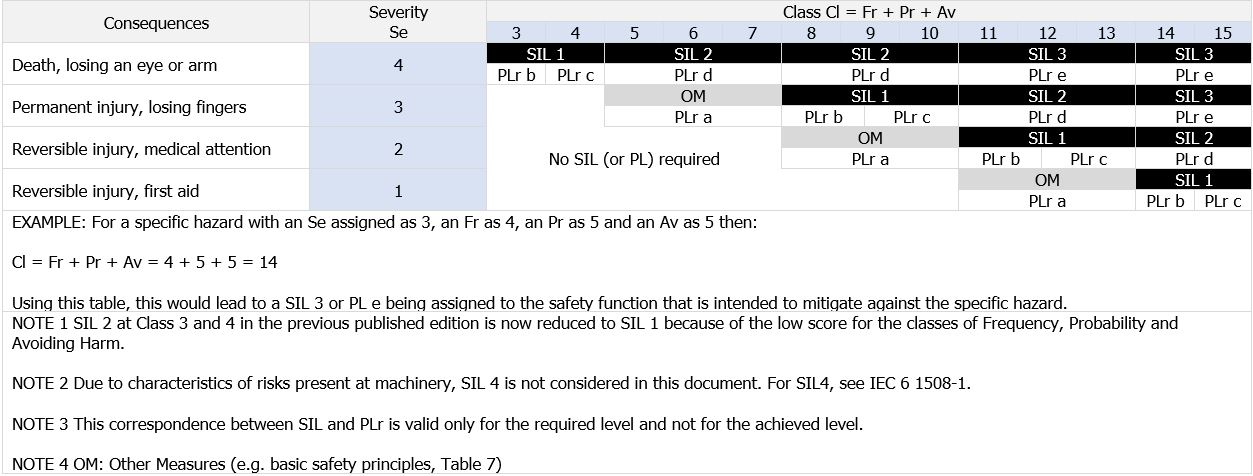
Table A.6 - Matrix assignment for determining the required SIL (or PLr) for a safety function
[...] segue in allegato
Fonti:
CEI EN IEC 62061:2022
UNI ISO/TR 14121-2:2013
UNI EN ISO 13849-1:2016
Direttiva 2006/42/CE
Add more
- Published: 09 March 2022
- Hits: 9940
Posted in News
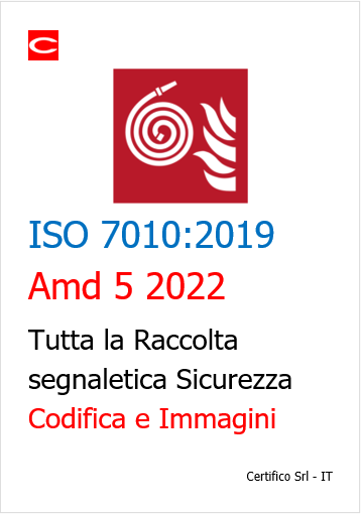
ISO 7010 Raccolta dei Segnali di sicurezza previsti dalla norma / Ed. 2022 Amd 5 Gennaio 2022
ID 15545 | Ed. 9.0 del 15 Gennaio 2022 / File immagini PNG e Lista segnaletica allegata
Aggiornata la raccolta segnaletica ISO 7010:2019, con altri segnali pubblicati con l'emendamento 5 di Gennaio 2022, in allegato:
- Raccolta immagini segnaletica Ed. 9.0 aggiornata con l'emendamento n. 5 di Gennaio 2022
Nuovi Pittogrammi Emendamento A5 Gennaio 2022
M056 - Ventilate before and during entering
M057 - Ensure continuous ventilation
M058 - Entry only with supervisor outside.
Nuovi Pittogrammi Emendamento A4 Dicembre 2021
F018: Fire alarm flashing light,
M059: Wear laboratory coat,
W073: Warning; Large-scale fire zone,
W074: Warning; Tornado zone,
W075: Warning; Active volcano zone,
W076: Warning; Debris flow zone,
W077: Warning; Flood zone,
W078: Warning; Landslide zone.
Nuovi Pittogrammi Emendamento A3 Luglio 2021
E067 - Evacuation mattress
E068 - Lifebuoy with light and smoke
E069 - Person overboard call point
F019 - Unconnected fire hose
Segnaletica EN ISO 7010 e Segnaletica allegato XXV del TUS
In relazione all'uso della segnaletica di sicurezza di cui all'Allegato XXV D.Lgs n. 81/2008 e s.m.i, che non è aggiornata e armonizzata rispetto alla segnaletica EN ISO 7010 si è espresso il MLPS con la:
- Circolare n. 30 del 16.07.2013
Segnaletica di sicurezza - D.Lgs n. 81/2008 e s.m.mi. allegato XXV - Prescrizioni generali. Uso e rispondenza dei pittogrammi con la Norma UNI EN ISO 7010:2017 - Chiarimenti
ISO 7010:2019
Graphical symbols - Safety colours and safety signs - Registered safety signs
Corrigenda/Amendments:
ISO 7010:2011/Amd 1:2012
ISO 7010:2011/Amd 2:2012
ISO 7010:2011/Amd 3:2012
ISO 7010:2011/Amd 4:2013
ISO 7010:2011/Amd 5:2014
ISO 7010:2011/Amd 6:2014
ISO 7010:2011/Amd 7:2016
ISO 7010:2011/Amd 8:2017
ISO 7010:2011/Amd 9:2018
ISO 7010:2019/Amd 1:2020
ISO 7010:2019/Amd 2:2020
ISO 7010:2019/Amd 3:2021
ISO 7010:2019/Amd 4:2021
ISO 7010:2019: https://www.iso.org/standard/72424.html
Dim.: 800 x 800 px
Formato: png
Add more
- Published: 26 January 2022
- Hits: 18948
Posted in News
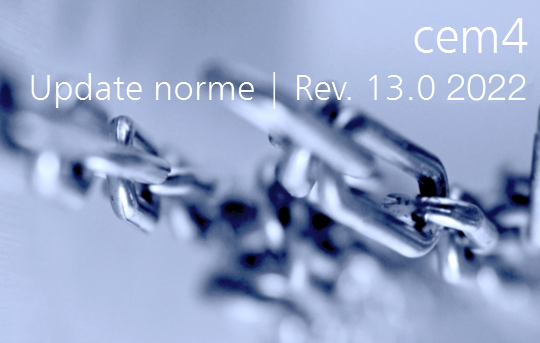
CEM4: Update norme Rev. 13.0 Gennaio 2022
ID 15336 | 24.01.2022 / Allegata Procedura
File di Aggiornamento Normativo RESS Direttiva macchine / Norme armonizzate Rev. 13.0 Gennaio 2022
Download Procedura Update normativo file CEM 13.0
File PDF/CEM di tutte le norme tecniche "Presunzione di Conformità" per ogni RESS della Direttiva macchine 2006/42/CE.
Con l’aggiornamento Update normativo, è possibile aggiornare il Database di CEM4 con richiamo dei dati delle norme utilizzate nella gestione della Valutazione dei Rischi relative ad ogni RESS Allegato I della Direttiva macchine 2006/42/CE in “Presunzione di Conformità”.
Eventuali modifiche alle norme riportate nei documenti interessati, sia dovute a personalizzazioni Utente o precedenti l’importazione del file Update norme CEM, saranno "congelate" alle norme preesistenti.
Importando il file Update norme CEM, saranno aggiornate le norme di riferimento (titoli ed eventuale descrizione) sottostanti ad ogni RESS.
Novità in questa Revisione 13.0 Gennaio 2022, che tiene conto delle Norme armonizzate Direttiva macchine del 14 Ottobre 2021 pubblicate con la Decisione di esecuzione (UE) 2021/1813 della Commissione del 14 ottobre 2021 (GU L 366/109 del 15.10.2021):
Aggiunta EN ISO 13849-2 RESS 1.2.1
Aggiunta EN ISO 13849-2 RESS 1.2.5
Aggiunta EN ISO 14122-4 RESS 1.6.2
Aggiunta EN 82079-1 RES 1.7.3 (Altro)
Aggiunta EN 82079-1 RES 1.7.4 (Altro)
Aggiunta EN 82079-1 RES 1.7.4.1 (Altro)
Aggiunta EN 848-1 RES 2.3
Aggiunta EN 848-2 RES 2.3
Aggiunta EN 848-3 RES 2.3
Aggiunta EN 859 RES 2.3
Aggiunta EN 860 RES 2.3
Aggiunta EN 861 RES 2.3
Aggiunta EN 940 RES 2.3
Aggiunta EN 1218-1 RES 2.3
Aggiunta EN 1218-2 RES 2.3
Aggiunta EN 1218-3 RES 2.3
Aggiunta EN 1218-5 RES 2.3
Aggiunta EN 1807-1 RES 2.3
Aggiunta EN 1807-2 RES 2.3
Aggiunta EN 1870-3 RES 2.3
Aggiunta EN 1870-4 RES 2.3
Aggiunta EN 1870-5 RES 2.3
Aggiunta EN 1870-6 RES 2.3
Aggiunta EN 1870-7 RES 2.3
Aggiunta EN 1870-8 RES 2.3
Aggiunta EN 1870-10 RES 2.3
Aggiunta EN 1870-11 RES 2.3
Aggiunta EN 1870-12 RES 2.3
Aggiunta EN 1870-13 RES 2.3
Aggiunta EN 1870-14 RES 2.3
Aggiunta EN 1870-15 RES 2.3
Aggiunta EN 1870-16 RES 2.3
Aggiunta EN 1870-17 RES 2.3
Aggiunta EN 1870-18 RES 2.3
Aggiunta EN 1870-19 RES 2.3
Aggiunta EN 12779 RES 2.3
Aggiunta EN 16770 RES 2.3
Aggiunta EN ISO 18217 RES 2.3
Aggiunta EN ISO 19085-1 RES 2.3
Aggiunta EN ISO 19085-2 RES 2.3
Aggiunta EN ISO 19085-3 RES 2.3
Aggiunta EN ISO 19085-4 RES 2.3
Aggiunta EN ISO 19085-5 RES 2.3
Aggiunta EN ISO 19085-6 RES 2.3
Aggiunta EN ISO 19085-7 RES 2.3
Aggiunta EN ISO 19085-8 RES 2.3
Aggiunta EN ISO 19085-9 RES 2.3
Aggiunta EN ISO 19085-10 RES 2.3
Aggiunta EN ISO 19085-11 RES 2.3
Aggiunta EN ISO 19085-12 RES 2.3
Aggiunta EN ISO 19085-13 RES 2.3
Aggiunta EN 848-1 RES 2.3
Aggiunta EN 848-2 RES 2.3
Aggiunta EN 848-3 RES 2.3
Aggiunta EN 859 RES 2.3
Aggiunta EN 860 RES 2.3
Aggiunta EN 861 RES 2.3
Aggiunta EN 940 RES 2.3
Aggiunta EN ISO 16122-1 RESS 2.4
Aggiunta EN ISO 16122-2 RESS 2.4
Aggiunta EN ISO 16122-3 RESS 2.4
Aggiunta EN ISO 16122-4 RESS 2.4
Aggiunta EN 82079-1 RESS 2.4
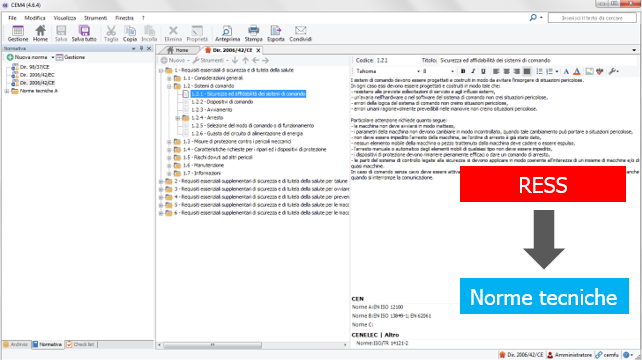
Maggiori informazioni
Download file CEM Update norme CEM4 Rev. 13.0 Gennaio 2022
- Published: 24 January 2022
- Hits: 13402
Posted in News
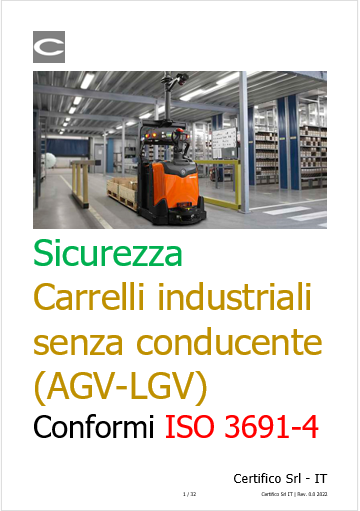
Sicurezza Carrelli industriali senza conducente (AGV-LGV) conformi ISO 3691-4:2020
Documento sulla sicurezza per l’uso dei sui carrelli industriali senza conducente a bordo AGV/LGV con:
- 1. Note principali norma (IT)
- 2. Estratto dei punti principali della norma di riferimento UNI EN ISO 3691-4:2020 (EN)
- 3. Documento SUVA AVG
_______
UNI EN ISO 3691-4:2020
Carrelli industriali - Requisiti di sicurezza e verifiche - Parte 4: Carrelli industriali senza guidatore a bordo e loro sistemi
La norma specifica i requisiti di sicurezza e i mezzi per la loro verifica per i carrelli industriali senza guidatore e i loro sistemi.
La norma, che ha sostituito integralmente la EN 1525:1999, è tipo di tipo C ed è il riferimento per la sicurezza dei carrelli industriali senza conducente.
_______
La norma, alla Data del Documento, non è armonizzata per la Direttiva macchine 2006/42/CE.
Vedi tutte le norme armonizzate Direttiva macchine
1. Note principali norma
CARRELLI
I Carrelli industriali senza conducente si distinguono in generale in:
AGV (Veicoli a Guida Automatica)
AGV (Veicoli a Guida Laser)
La norma definisce in generale la sicurezza degli AGV/LGV e delle aree/impianti asserviti da AGV/LGV
ALLEGATO A
L'allegato A stabilisce definisce le zone per il percorso del carrello ed i requisiti minimi per operare in sicurezza.
ZONA OPERATIVA:
Su entrambi i lati del percorso del carrello deve essere previsto uno spazio libero minimo di 0,5 m di larghezza per un'altezza di 2,1 m.
Questo deve essere misurato tra il percorso e le strutture fisse adiacenti lungo il percorso.
ZONA OPERATIVA PERICOLOSA:
Una zona con spazio libero inadeguato (vedi A.2.1) o una zona che non può essere protetta da mezzi di rilevamento del personale essere designata come "zona di pericolo operativo" (vedi tabella A.1 e tabella A.2) e contrassegnata di conseguenza. Una zona di pericolo operativo deve essere chiaramente indicata da opportuna segnaletica o preferibilmente da segnaletica a terra. Deve essere evitata confusione con altri segni e segni.
In questa zona di pericolo operativo, la velocità del carrello deve essere conforme alla tabella A.1 e alla tabella A.2 e il carrello deve emettere avvisi acustici e/o ottici aggiuntivi.
Se c'è spazio libero insufficiente e nessuna via di fuga pedonale di almeno 0,5 m di larghezza e 2,1 m di altezza (vedi Tabella A.1 e Tabelle A.2, C.1, C.2 e C.3 dimensioni di ingombro), i mezzi di rilevamento del personale devono essere attivi per garantire il rilevamento di persone entro 180 mm tra il bordo dei campi di sicurezza dell'ESPE e gli oggetti circostanti al fine di verificare che questa zona sia libera da persone (ad esempio depositi a blocchi).
ESEMPIO Un esempio di zona di pericolo operativa può essere l'area di trasferimento del carico (vedere A.2.5).
ZONA RISTRETTA
Una zona con spazio libero inadeguato (vedere A.2.1) e che non può essere protetta da mezzi di rilevamento del personale secondo 4.8.2.1 deve essere designata "zona ristretta" (vedere Tabella A.1 e Tabella A.2) e contrassegnata di conseguenza.
ESEMPIO
Esempi di zone soggette a restrizioni possono essere un magazzino a blocchi o un magazzino a corsie strette o Very Narrow Aisle (VNA).
La zona ristretta deve:
a) essere chiaramente contrassegnata da segnaletica e segnaletica orizzontale a terra;
b) avere accesso limitato al personale autorizzato e formato sui rischi specifici;
c) non includere alcun luogo di lavoro;
d) essere muniti di ripari fissi perimetrali conformi alla norma ISO 13857:2008, Tabella 2 e Tabella 4 di almeno 2,1 m di altezza;
e) essere muniti di un riparo mobile (es. porta) per consentire l'accesso al personale autorizzato.
ZONA CONFINATA:
Una zona in cui i mezzi di rilevamento del personale possono essere omessi e in cui è consentita qualsiasi velocità. Questa zona deve essere designata "zona confinata" e contrassegnata di conseguenza.
La zona confinata deve:
a) essere chiaramente contrassegnati da segnaletica e segnaletica orizzontale/terra;
b) avere accesso limitato al personale autorizzato;
c) non includere alcun luogo di lavoro;
d) essere chiusa con ripari fissi conformi al 4.1.6 e alti almeno 2,1 m; e
e) essere munita di un riparo mobile interbloccato con blocco del riparo (porta) conforme al punto A.2.4.2 per consentire l'accesso al personale autorizzato.
...
2. Estratto norma UNI EN ISO 3691-4:2020 (EN)
4.7 Stability
4.7.1 General
The truck shall remain stable in all operating conditions and during all load-handling and travelling movements, including an emergency stop.
4.8.1 Emergency stop
Trucks shall be provided with an emergency stop function that complies with ISO 13850:2015. When the emergency stop device is actuated, all truck movements shall stop.
The emergency stop devices shall be clearly visible, identifiable and accessible from both ends and both sides of the truck. If the truck has a defined operator position with controls, an emergency stop device shall be fitted near these controls.
However, in the case of trucks carrying a load that restricts access to the emergency stop device(s), the emergency stop device(s) shall be mounted on accessible rigid part(s) of the truck closest to the hazard zone (see Figure 2, for example).
The safety-related parts of the control system for emergency stop function shall be in accordance with Table 1, item 15.
...
Vedi tutto il Documento
- Published: 17 January 2022
- Hits: 13367
Posted in News
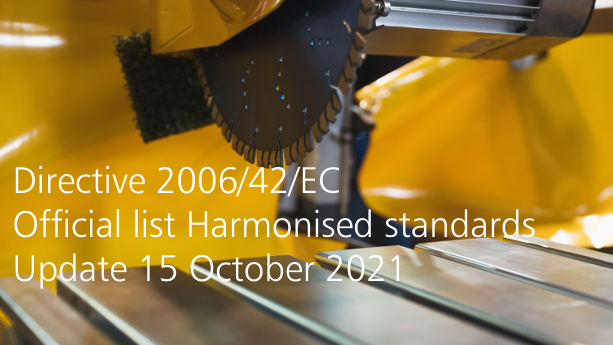
Directive 2006/42/EC: Harmonised standards published in the OJ | Update 15 October 2021 / Format PDF / XLS
Summary of references of harmonised standards form machinery directive 2006/42/EC update Decision (EU) 2021/1813 of 14 October 2021 (GU L 366/109 of 15.10.2021)
________
Summary of references of harmonised standards published in the Official Journal - Directive 2006/42/EC of the European Parliament and of the Council of 17 May 2006 on machinery, and amending Directive 95/16/EC
The summary below consolidates the references of harmonised standards published by the Commission in the Official Journal of the European Union (OJ). It reproduces information already published in the L or C series of the OJ as indicated in columns (2), (5) and/or (7). It contains all references which, when the summary was generated, still provided a presumption of conformity together with references already withdrawn from the OJ.
The Commission services provide this summary for information purposes only. Although they take every possible precaution to ensure that the summary is updated regularly and is correct, errors may occur and the summary may not be complete at a certain point in time. The summary does not as such generate legal effects.
This summary was generated on 15 October 2021
Fonte: EC
Download List
- Published: 08 November 2021
- Hits: 22727
Posted in News
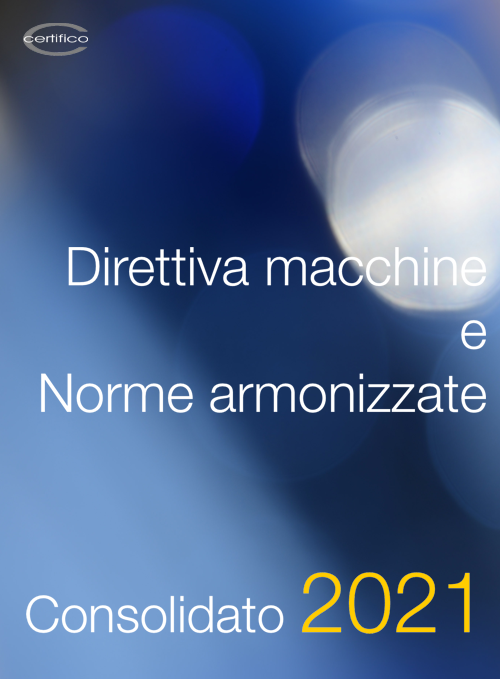
Direttiva macchine e norme armonizzate consolidato / Ottobre 2021
Update Ed. 19.0 del 15 Ottobre 2021
Nell'Ed. 19.0 il Testo della Direttiva macchine è aggiornato con le norme armonizzate di cui alla Decisione di esecuzione (UE) 2021/1813.
______
Testo consolidato Direttiva macchine e norme armonizzate 2020 - tutte le modifiche e rettifiche dal 2009 al 2021 e norme tecniche armonizzate in vigore 2019 disponibile EPUB/PDF.
Il testo tiene conto delle seguenti modifiche e rettifiche dal 2006 al 2021:
1. Direttiva macchine (testo nativo)
Direttiva 2006/42/CE del Consiglio, del 17 maggio 2006, relativa alle macchine e che modifica la direttiva 95/16/CE (GU L 157 del 9.6.2006)
2. Modifiche:
Regolamento (CE) n. 596/2009 del Parlamento europeo e del Consiglio del 18 giugno 2009 (GU L 188 14 18.7.2009)
"Aggiornamento dell’elenco indicativo dei componenti di sicurezza e alle misure in materia di limitazione dell’immissione sul mercato di macchine potenzialmente pericolose"
Direttiva 2009/127/CE del Parlamento europeo e del Consiglio del 21 ottobre 2009 (GU L 310 29 25.11.2009)
"Macchine pesticidi"
Regolamento (UE) n. 167/2013 del Parlamento europeo e del Consiglio del 5 febbraio 2013 (GU L 60/1 del 2.3.2013)
"Omologazione e vigilanza del mercato dei veicoli agricoli e forestali"
Direttiva 2014/33/UE del Parlamento europeo e del Consiglio del 26 febbraio 2014 (GU L 96/251 del 29.3.2014)
"Ascensori e componenti di sicurezza per ascensori"
Regolamento (UE) 2019/1243 del Parlamento europeo e del Consiglio del 20 giugno 2019 (L 198 241 25.7.2019)
Adattamento agli articoli 290 e 291 del trattato sul funzionamento dell’Unione europea una serie di atti giuridici che prevedono il ricorso alla procedura di regolamentazione con controllo
3. Rettifiche:
Rettifica, GU L 76 del 16.3.2007, pag. 35 (2006/42/CE)
4. Recepimento
Decreto Legislativo 27 Gennaio 2010 n. 17 (GU n. 41 del 19 febbraio 2010)
"Attuazione della direttiva 2006/42/CE, relativa alle macchine e che modifica la direttiva 95/16/CE relativa agli ascensori"
5. Norme tecniche armonizzate
Elenco Norme armonizzate Direttiva macchine 2006/42/CE a Ottobre 2021
Dal 1° dicembre 2018 i riferimenti delle norme armonizzate sono pubblicati e ritirati dalla Gazzetta ufficiale dell'Unione europea non più come "Comunicazioni della Commissione" ma mediante "Decisioni di esecuzione della Commissione" (Vedasi Com.(2018) 764 EC).
I riferimenti pubblicati ai sensi della direttiva 2006/42/CE sulle macchine sono contenuti nelle:
1. Comunicazione della Commissione pubblicata nella GU C 092 del 9 marzo 2018 (GU C 92/1 del 9 marzo 2018)
2. Decisione di esecuzione (UE) 2019/436 della Commissione, del 18 marzo 2019 (GU L 75 del 19 marzo 2019)
3. Decisione di esecuzione (UE) 2019/1766 della Commissione del 23 ottobre 2019 (GU L 270/94 del 24 Ottobre 2019)
4. Decisione di esecuzione (UE) 2019/1863 della Commissione del 6 novembre 2019 (GU L 286/25 07 novembre 2019)
5. Decisione di esecuzione (UE) 2020/480 della Commissione del 1° Aprile 2020 (GU L 102/6 del 02.04.2020)
6. Decisione di esecuzione (UE) 2021/377 della Commissione del 2 marzo 2021 (GU L 72/12 del 3.3.2021)
7. Decisione di esecuzione (UE) 2021/1813 della Commissione del 14 ottobre 2021 (GU L 366/109 del 15.10.2021)
Edizione: 19.0
Sistemi Operativi: iOS/Android
Pubblicato: 15/10/2021
Editore: Certifico s.r.l.
Lingue: Italiano
ISBN 978-8-8907-4475-4
Formato PDF: Riservato Abbonati Direttiva macchine/4X/Full
Download PDF
Download Google Play
Download Apple Store
Collegati:
Vedi la nuova sezione "Norme armonizzate click"
- Published: 15 October 2021
- Hits: 25122
Posted in News
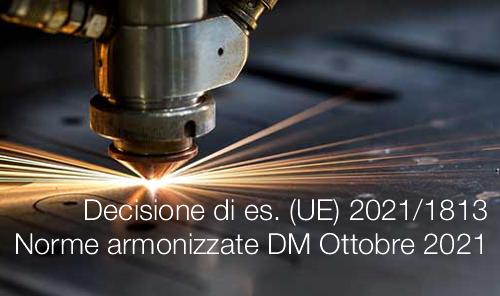
Decisione di esecuzione (UE) 2021/1813 | Norme armonizzate DM Ottobre 2021
Decisione di esecuzione (UE) 2021/1813 della Commissione del 14 ottobre 2021 che modifica la decisione di esecuzione (UE) 2019/436 per quanto riguarda le norme armonizzate per le attrezzature per servizi aeroportuali di rampa, gli apparecchi di sollevamento, gli utensili estrattivi e altre macchine redatte a sostegno della direttiva 2006/42/CE del Parlamento europeo e del Consiglio, e che abroga la decisione di esecuzione (UE) 2015/27 della Commissione
GU L 366/109 del 15.10.2021
Entrata in vigore: 15.10.2021
Il punto 1 dell'allegato I si applica a decorrere dal 15 aprile 2023.
Entrano in regime di armonizzazione, in particolare tra quelle di tipo B, le norme:
- EN 1837:2020 Sicurezza del macchinario - Illuminazione integrata alle macchine
- EN ISO 11553-1:2020 Sicurezza del macchinario - Macchine laser - Parte 1: Requisiti generali di sicurezza (ISO 11553-1:2020) EN ISO 11553-1:2020/A11:2020
Maggiori info
Elenco Norme armonizzate Direttiva macchine 2006/42/CE a Ottobre 2021
- Published: 15 October 2021
- Hits: 22819
Posted in News

CEM4 July 2021 Update
09 Jully 2021
- Published: 09 July 2021
- Hits: 20559
Posted in News
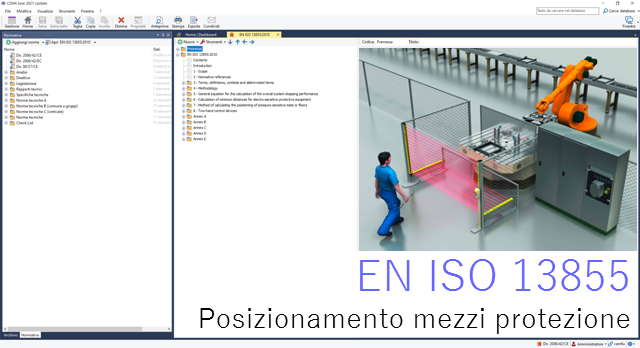
EN ISO 13855 Posizionamento dei mezzi di protezione | File CEM
ID 13831 | File .CEM importabile in CEM4
UNI EN ISO 13855:2010
Sicurezza del macchinario - Posizionamento dei mezzi di protezione in funzione delle velocità di avvicinamento di parti del corpo umano
La presente norma è la versione ufficiale in lingua inglese della norma europea EN ISO 13855 (edizione maggio 2010). La norma stabilisce il posizionamento dei mezzi di protezione in funzione delle velocità di avvicinamento di parti del corpo umano.La norma specifica i parametri basati sui valori delle velocità di avvicinamento delle parti del corpo umano e fornisce un metodo per determinare le distanze minime tra una zona pericolosa e la zona di rilevamento o il dispositivo di azionamento dei mezzi di protezione.
...
Maggiori info
- Published: 22 June 2021
- Hits: 19983
Posted in News
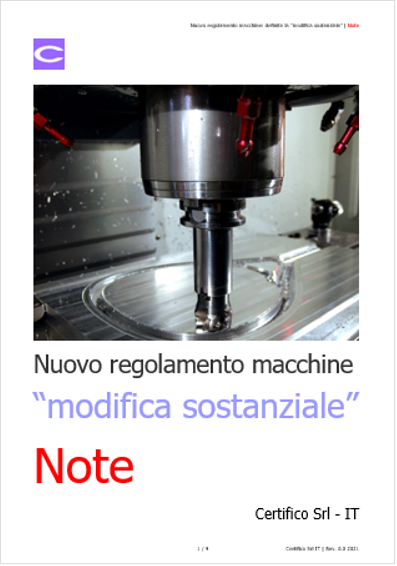
Nuovo Regolamento macchine: definita la "modifica sostanziale" | Note
ID 13797 | 16.06.2021 / Documento completo allegato
Nel nuovo Regolamento macchine 2021 (proposta) prevista la definizione di "modifica sostanziale" ad una macchina e gli obblighi per chi apporta tale modifica.
Indicazioni su “modifiche” alle macchine sono presenti nella Guida Ufficiale Direttiva macchine IT 2010 ed EN 2019 (vedi in fondo documento).
Si illustrano i periodi d’interesse del nuovo Regolamento macchine (proposta).
Considerando (23)
Al fine di garantire che le macchine, quando immesse sul mercato o messe in servizio, non comportino rischi per la salute e la sicurezza delle persone o degli animali domestici e non arrechino danni alle cose e, se del caso, all'ambiente, devono essere soddisfatti i requisiti essenziali di salute e sicurezza.
Qualora le macchine siano successivamente modificate, fisicamente o digitalmente, in un modo non previsto dal fabbricante e tale modifica posso comportare che non siano più soddisfatti i pertinenti requisiti essenziali di salute e sicurezza, la modifica deve essere considerata sostanziale.
Ad esempio, gli utilizzatori possono caricare un software nella macchina che non è previsto dal fabbricante e che può generare nuovi rischi. Al fine di garantire la conformità di tale prodotto con i relativi requisiti essenziali di salute e sicurezza, la persona che effettua la modifica sostanziale dovrebbe eseguire una nuova valutazione di conformità prima di immettere sul mercato la macchina modificata o di metterla in servizio.
Tale requisito dovrebbe applicarsi solo alla parte modificata della macchina, a condizione che la modifica non influisca sulla macchina nel suo complesso. Al fine di evitare un onere inutile e sproporzionato, la persona che effettua la modifica sostanziale non dovrebbe essere tenuta a ripetere i test e produrre nuova documentazione in relazione ad aspetti della macchina che non sono interessati dalla modifica.
Dovrebbe spettare alla persona che esegue la modifica sostanziale dimostrare che la modifica non ha un impatto sulla macchina nel suo complesso.
Art. 3 Definizioni
«modifica sostanziale»: modifica di una macchina, mediante mezzi fisici o digitali dopo che la macchina è stata immessa sul mercato o messa in servizio, non prevista dal fabbricante e per cui la conformità della macchina ai pertinenti requisiti essenziali di salute e sicurezza potrebbe essere alterata;
Articolo 15 Altri casi in cui si applicano gli obblighi dei fabbricanti
Una persona fisica o giuridica, diversa dal fabbricante, dall'importatore o dal distributore, che apporta una modifica sostanziale alla macchina deve essere considerato un fabbricante ai fini del presente regolamento ed è soggetto agli obblighi del fabbricante di cui all'articolo 10 per la parte della macchina interessata dalla modifica o, se la modifica sostanziale ha un impatto sulla sicurezza della macchina nel suo complesso, per l'intera macchina.
...
segue
Maggiori Info
- Published: 16 June 2021
- Hits: 21286
Posted in News
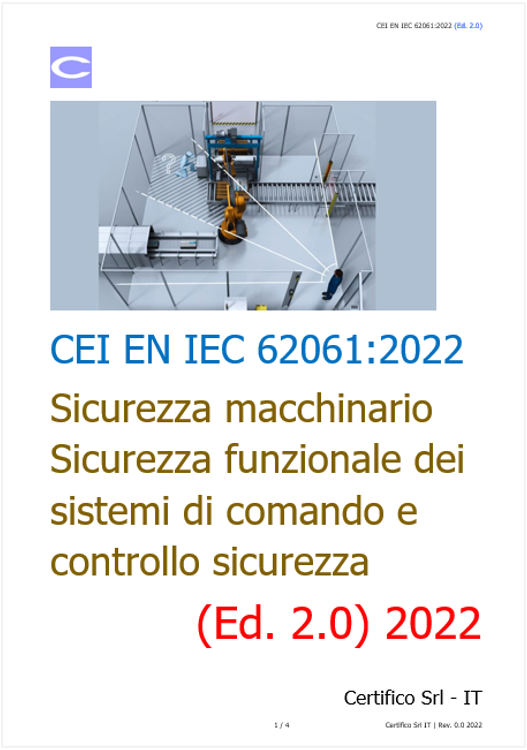
CEI EN IEC 62061:2022 (Ed. 2.0)
ID 15736 | 11.02.2022 / Nota e Preview in allegato
Sicurezza del macchinario - Sicurezza funzionale dei sistemi di comando e controllo relativi alla sicurezza
Classificazione CEI: 44-16
Pubblicazione: 2022-01
La presente Norma prescrive requisiti e fornisce raccomandazioni per la progettazione, l'integrazione e la convalida dei sistemi di controllo relativi alla sicurezza (SCS) per le macchine.
È applicabile ai sistemi di controllo utilizzati, singolarmente o in combinazione, per svolgere funzioni di sicurezza su macchine non trasportabili manualmente durante il lavoro, compreso un gruppo di macchine che lavorano insieme in modo coordinato. La presente è una Norma specifica per il settore dei macchinari nell'ambito della serie di Norme CEI EN 61508 (tutte le parti).
La progettazione di sottosistemi elettronici programmabili complessi o elementi di sottosistemi non rientra nell'ambito di questa Norma.
Questa Norma specifica i requisiti generali per la progettazione e la verifica di un sistema di controllo relativo alla sicurezza destinato ad essere utilizzato in modalità a domanda alta/continua La presente Norma affronta esclusivamente i requisiti di sicurezza funzionale volti a ridurre il rischio di situazioni pericolose e si applica ai rischi derivanti direttamente dai pericoli della macchina stessa o da un gruppo di macchine che lavorano insieme in modo coordinato.
La Norma in oggetto sostituisce completamente la Norma CEI EN 62061:2005-09, che rimane applicabile fino al 26-04-2024.
Questa Norma viene pubblicata dal CEI in una prima fase nella sola lingua inglese, per consentirne l'immediato utilizzo da parte degli utenti interessati, nel rispetto della data di pubblicazione fissata dagli Enti Normatori internazionali.
Successivamente il CEI pubblicherà, in un nuovo fascicolo, la versione solo italiana; tale versione avrà la stessa validità della presente.
La presente Norma recepisce il testo originale inglese della Pubblicazione IEC.
...
Add more
- Published: 11 February 2022
- Hits: 14026
Posted in News
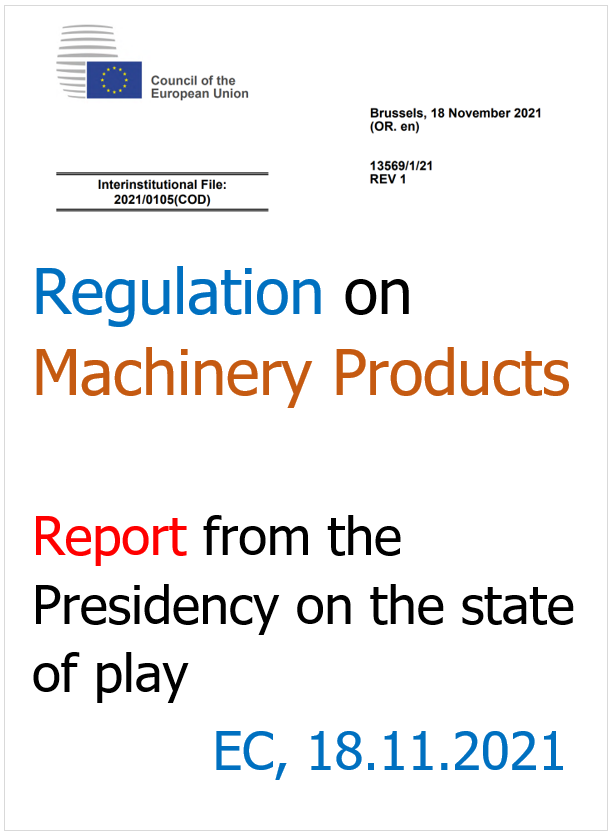
Report Regulation on Machinery Products on the state of play - 18.11.2021
Brussels, 18 November 2021 (13569/1/21 REV 1)
_____
I. INTRODUCTION
The European Commission proposal on Machinery Products was transmitted to the European Parliament and to the Council on 22 April 2021. The proposal was presented in the package together with the proposal for the Act on Artificial Intelligence. The two are aligned as the Machinery Products proposal aims to remain future-proof in light of new technologies. As the issue of artificial intelligence represents one of the priorities of the Presidency, the Presidency attributes an important role to the Machinery Products proposal.
The examination of the proposal in the Council Working Party on Technical Harmonisation started on 26 April 2021 under the Portuguese Presidency.
There were all-in-all 12 meeting days until 25 November 2021, eight of them under the Slovenian Presidency. The Commission`s impact assessment was examined with the help of an indicative questionnaire.
II. MAIN ISSUES
In general, the transmission of the Commission’s proposal has been welcomed as timely, necessary and in line with the good inter-institutional practice. Stakeholders have been heard sufficiently by the Commission and the objective of bringing products with digital content into the scope of the machinery regulation has been accepted.
During the discussions at the Working Party level some essential comments were raised.
Terminology regarding machinery/machinery products
The introduction of the term “machinery products” that partly replaces the currently used term “machinery” demands for considerable attention and the topic was addressed in the Working Party meetings on different occasions. Many Member States would prefer to keep the current wording (“machinery”) as they do not see the added value in the introduced changed wording. They claim that market surveillance authorities do not experience difficulties while using the current wording and they believe that the proposed change in wording could limit the clarity of the text and bring translation issues. On the basis of the Member States’ comments an alternative suggestion was formulated by the Commission where the term “machinery” was coupled with the term “machine/s” but such a solution also brought considerable reservations of many Member States particularly due to translation issues.
Exclusion of »vehicles which have as their only objective the transport of goods or persons by public road, air, water or rail network except for machinery mounted on those vehicles" from the scope of the regulation
Member States are very careful with the suggested exclusion particularly from the perspective of the exclusion of small transport vehicles for personal use or light electric vehicles such as escooters, e-bikes that are widely used but could, on the basis of this Proposal, remain unregulated and consequently potentially dangerous for users. Many Member States would therefore like to keep such vehicles in the scope of the Proposal even when road circulation risk is not covered by the Proposal as is the case with the current Machinery Directive. Some Member States also call for the introduction of the transition period until relevant legislation regulating the mentioned type of vehicles is passed.
Empowerment of the Commission to elaborate technical specifications when standards are not available
Member States expressed their support for the primary role of standards and are therefore rather reserved regarding such an empowerment of the Commission particularly in the area where no considerable issues regarding standardisation have been detected. They can potentially agree to a strengthened wording on the issue of such technical specification only representing the final resort option under specific circumstances.
The list of high-risk products in Annex I
Member States and the Commission agree that the mentioned list needs updating but Member States expect this update during the process of adoption of this Proposal while the Commission claims that they do not have enough data to do so but would adapt the list right after the adoption of this Proposal.
Third-party conformity assessment
Linked to the necessity to update the Annex I is also the newly introduced necessity for third-party conformity assessment procedure of high-risk products (use of module B). Such a requirement represents a considerable burden, particularly for SMEs, and some Member States therefore demand for either maintaining the currently relevant option of self-assessment type of conformity assessment (use of module A) or for a considerable adaptation of the Annex I where the high-risk machinery products are listed.
The recurrent issue in the Working Party meetings was also the issue of definitions that need to be properly specified and agreed upon (substantial modification, artificial intelligence) while the issue of alignment with the NLF was consistently addressed.
The Presidency aims to finish the first examination of the Proposal and intends to finalise it by an examination of the essential health and safety requirements of the machinery products in Annex III.
The length and complexity of this Annex will demand for considerable time for its examination.
The Presidency also strives to present the first partial Presidency compromise text of the Proposal.
III. OUTLOOK
The draft report by the rapporteur, Mr Ivan Štefanec (EPP), will be discussed in the Committee on the Internal Market and Consumer Protection (IMCO) of the European Parliament as from November 2021 and the vote on the draft amendments is expected to take place in March 2022. It will thus be for the incoming French Presidency to intensify contacts with the representatives of the European Parliament in order to find compromise solutions that are acceptable both to the Council and the European Parliament with a view to making an agreement at first reading possible.
The Slovenian Presidency thanks the Portuguese Presidency for starting the discussions, all delegations for their contributions to the file, and the European Commission for its collaborative attitude and fruitful comments necessary to improve the text of the proposal.
[...]
Fonte: EC
Add more
- Published: 25 January 2022
- Hits: 13241
Posted in News
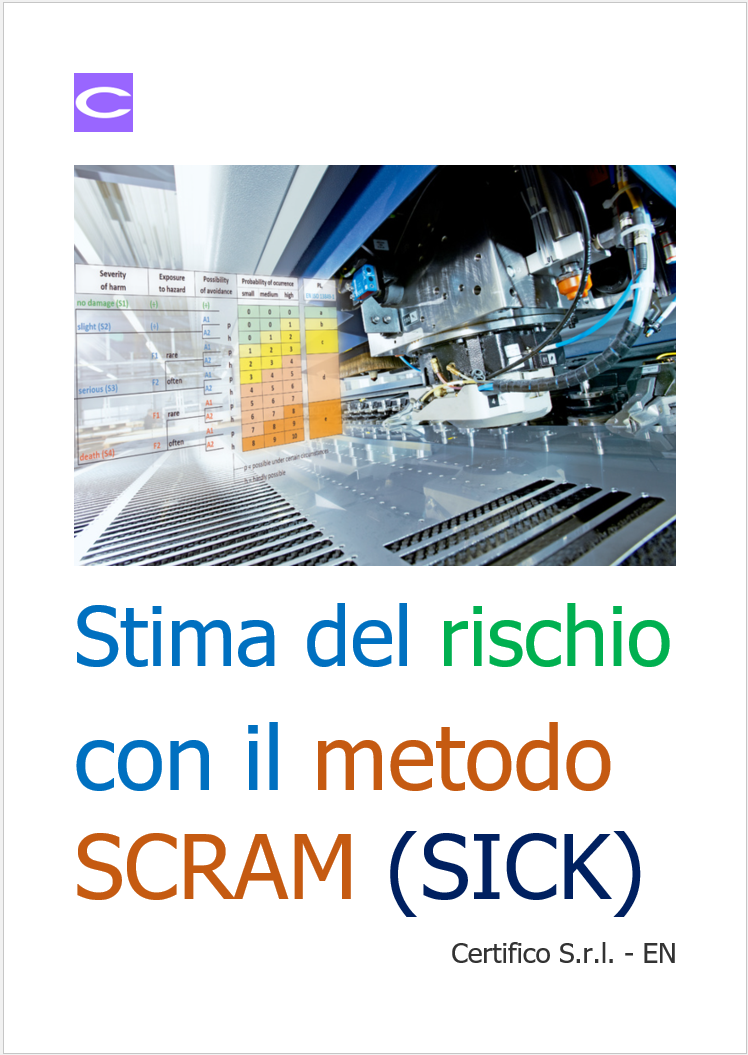
Stima del rischio con il metodo SCRAM (SICK)
ID 15490 | 19.01.2022 / Documento completo (EN)
Risk assessment and risk reduction for machinery - Part 3: Conducting risk estimation. Scalable risk analysis and evaluation method (SCRAM)
Fonte: SICK AG - WHITE PAPER 2019-02
….
Introduction
Scope
Machine risk assessment consists of a series of steps used to examine the hazards associated with machines and it consists of two stages, namely risk analysis and risk evaluation, as laid out in ISO 12100:2012. Risk analysis comprises three stages: determining the limits of the machine, identifying hazards, and estimating the risk.
After having completed the hazard identification phase, risk estimation is carried out for each identified hazard and hazardous situation. Risk is defined as a combination of the severity of harm and the probability of occurrence of that harm.
According to ISO 12100:2012, the probability of occurrence of harm can be estimated taking into account the frequency and duration of exposure to the hazard, the probability of occurrence of a hazardous event, and the technical and human possibilities to avoid or limit the harm. The combination of the severity of the possible harm with these three probability parameters will be used to estimate risk values which can then be used for comparison purposes. At the last stage of the assessment process, risk evaluation allows decisions on risk reduction measures to be applied to the machine.
The scope of this white paper is to provide a risk estimation methodology that has proved to be robust, and reliable while preventing errors when estimating risks.
Preface
This white paper is part of a series of papers describing the SICK process of risk assessment in combination with risk reduction:
- Part 1: Defining the scope of the risk assessment
- Part 2: Identifying task/hazard pairs
- Part 3: Conducting risk estimation
- Part 4: Integrating protective devices into (existing) control systems
- Part 5: Implementing emergency operations
- Part 6: Carrying out substantial modifications
Risk reduction process
General
All products and systems include hazards and, therefore, some level of risk. However, the risk associated with those hazards shall be reduced to an acceptable or tolerable levela. The iterative process of risk assessment and risk reduction for each task and hazard combination is essential in achieving acceptable risk (level of risk that is accepted in a given context based on the current values of society).
The objective of risk reduction can be achieved by the elimination of significant hazards, or by reducing each of the two elements (separately or simultaneously) that determine the associated risk:
- Severity of harm from the hazard under consideration
- Probability of occurrence of that harm
...
Add more
- Published: 19 January 2022
- Hits: 12918
Posted in News
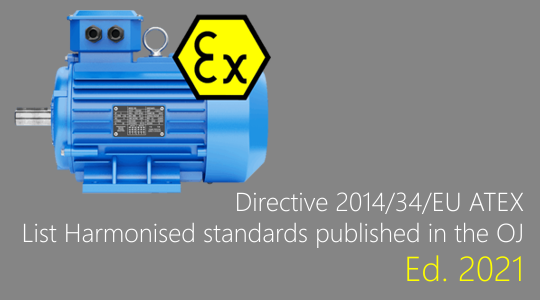
Directive 2014/34/EU ATEX: List Harmonised standards published in the OJ | 2021
ID 15294| Update 27 December 2021 / List XLS file in IT
In attachment:
List as PDF file - EN
List as XLS file - EN
List as XLS file - IT
Summary of references of harmonised standards published in the Official Journal – Directive 2014/34/EU of the European Parliament and of the Council of 26 February 2014 on the harmonisation of the laws of the Member States relating to equipment and protective systems intended for use in potentially explosive atmospheres
The summary below consolidates the references of harmonised standards published by the Commission in the Official Journal of the European Union (OJ). It reproduces information already published in the L or C series of the OJ as indicated in columns (2), (5) and/or (7). It contains all references which, when the summary was generated, still provided a presumption of conformity together with references already withdrawn from the OJ.
The Commission services provide this summary for information purposes only. Although they take every possible precaution to ensure that the summary is updated regularly and is correct, errors may occur and the summary may not be complete at a certain point in time. The summary does not as such generate legal effects.
This summary was generated on 31 August 2021
Fonte: EC
Download List
Collegati
- Published: 28 December 2021
- Hits: 13653
Posted in News
New Machine Regulation 2021: amendments of 20 October 2021
2021/0105(COD) 20.10.2021
Draft Report on the proposal for a regulation of the European Parliament and of the Council on Machinery products (COM(2021)0202 – C9-0145/2021 - 2021/0105(COD))
Committee on the Internal Market and Consumer Protection
EXPLANATORY STATEMENT
The Machinery Directive 2006/42/EC establishes a regulatory framework for placing machinery on the Single Market, ensuring its free movement and a high level of protection for users and other persons exposed to machinery products.
On 21 April 2021, the Commission put forward a proposal to revise the Machinery Directive.
The proposed revision came 15 years after the adoption of the Machinery Directive, currently in force, reflecting the Commission Work Programme 2020 under the priority ‘A Europe fit for the Digital Age’. In parallel, the Commission proposed a new Artificial Intelligence Act, with the main goal to reflect the change of the digital transition and the impact of new technologies on the Union product safety legislation.
As the machinery sector is an essential part of the engineering industry and one of the industrial pillars of the EU economy, the Rapporteur finds it very important to consider changes to its legislative framework with due care in order to secure sustainable recovery from the COVID-19 crisis while enabling innovation and new design development, and to keep European producers and designers competitive at the global level playing field.
The Rapporteur welcomes the Commission proposal for a Regulation on machinery products and fully supports its alignment with the New Legislative Framework (NLF) as it brings coherence with the other legislative acts on products safety and horizontal transparency. The Rapporteur also supports the conversion of the Directive into a Regulation as it facilitates uniform application across all EU Member States and therefore the free movement of goods.
While preparing the draft report, the Rapporteur carried out a broad consultation with stakeholders, listening to views and needs of the manufacturers, notified bodies and consumers, and, in addition discussing the proposal with the Commission. On that basis, the Rapporteur proposes the following main changes to the Commission proposal.
1. Scope and definitions
The Rapporteur proposes clarifying the scope, in particular with regard to the exclusion of motor vehicles from the Regulation. In addition, the Rapporteur proposes clarifications of several definitions, such as ‘safety component’ ‘substantial modification’ and ‘manufacturer’, and suggests new definitions on ‘machinery product’, ‘safety function’, ‘technical documentation’ and ‘lifecycle’ in order to contribute to the clearer understanding of the
enacting provisions.
Since the Regulation applies to ‘machinery products’ which, according to the Commission proposal, cover also ‘partly completed machinery’, the Rapporteur considers it important to make a clearer distinction between the definitions applying to ‘partly completed machinery’ and those applying to other categories of machinery products.
This distinction should also be made in respect of the requirements for machinery products in general and those for ‘partly completed machinery’, and in respect of the obligations, including (conformity) assessment procedures, of economic operators.
2. High-risk machinery products
The Rapporteur proposes that the term ‘high-risk machinery products’ be replaced by ‘potentially high-risk machinery products’ throughout the text as he considers that machinery products placed nowadays on the market do not present a high risk by default but only in certain situations.
In addition, in respect of the Commission empowerment to adopt delegated acts to amend Annex I listing potentially high-risk machinery products, the Rapporteur proposes that such delegated acts should not apply earlier than 36 months after their entry into force, so that manufacturers have enough time to adapt their design and production.
The Rapporteur emphasised in the report that machinery products should comply with the essential health and safety requirements when placed on the market or put into service.
Finally, in Annex III the rapporteur specified that the remote control for supervisory control function for autonomous operations should be implemented only as an option, ensuring that the remote actions do not increase the level of risk.
3. Conformity assessment of potentially high-risk machinery products
The Rapporteur proposes to keep the possibility for the manufacturers to use also the internal production control procedure (module A) set out in Annex VI for potentially high-risk machinery products, as he is not convinced that there are enough arguments for removing this option, while keeping in mind both the safety of machinery products and the machinery sector competitiveness and flexibility for innovation. In addition, keeping the possibility of using the internal production control procedure is of particular importance for SMEs.
Moreover, the Rapporteur believes that manufacturer’s authorised representative should not have a mandate for ensuring conformity assessment for machinery products or to be responsible for preparing technical documentation. The manufacturer should be the only responsible for these tasks, in line with the provisions of NLF.
4. Commission empowerment to adopt technical specifications
In respect of the Commission proposal to be able to exceptionally adopt implementing acts establishing technical specifications for the essential health and safety requirements in case of absence of harmonised standards, the Rapporteur proposes that such technical specifications do not apply should harmonised standards be developed in the future. Also, the Rapporteur believes that technical specifications could be drafted by the Commission only if European standardisations organisations have not delivered harmonised standards 3 years after the standardisation request.
5. Documentation
All relevant technical documentation, assembly instructions and declarations should be provided in digital or paper form and, if provided digitally, should be accessible during the whole lifecycle of the machinery product.
6. Market surveillance
The Rapporteur clarifies the rights of Member states’ market surveillance authorities and duties of economic operators in case where a machinery product does not comply with the requirements in this Regulation or poses a risk. While doing that, he strives to align the provisions on market surveillance with the Market Surveillance Regulation (EU) 2019/1020.
7. Deadlines and transitional provisions
The Rapporteur proposes extending the deadline for the repeal of Directive 2006/42/EC from 30 to 48 months after the date of entry into force of the new Regulation. In line with that, the transitional period has been extended from 42 to 60 month, as well, and the deadline for the Commission to present its first report on the evaluation of the Regulation from 54 to 72 months.
Finally, the date of application of the Regulation was postponed from 30 to 48 months after its entry into force.
Download Report PDF
- Published: 29 October 2021
- Hits: 23494
Posted in News
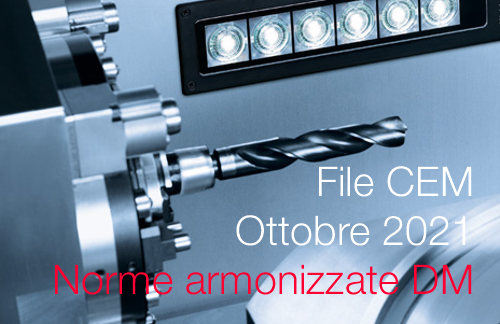
Norme armonizzate Direttiva macchine Ottobre 2021: il File CEM
Importa il File CEM in CEM4, e visualizza tutti i titoli delle norme armonizzate per Direttiva macchine aggiornamento Ottobre 2021
Elenco Norme armonizzate Direttiva macchine 2006/42/CE ad Ottobre 2021, in formato CEM, dei Titoli delle norme armonizzate per la Direttiva macchine 2006/42/CE aggiornato:
Con il file CEM è possibile tenere sotto controllo in CEM4, nell'Archivio normativa, tutte le Norme armonizzate (n. 787), suddivise per CEN/CENELEC/Tipo A/B/C, consultare, gestire direttamente da CEM4 e commentare le stesse.
Download File CEM Norme armonizzate
Norme armonizzate online
- Published: 15 October 2021
- Hits: 23400
Posted in News
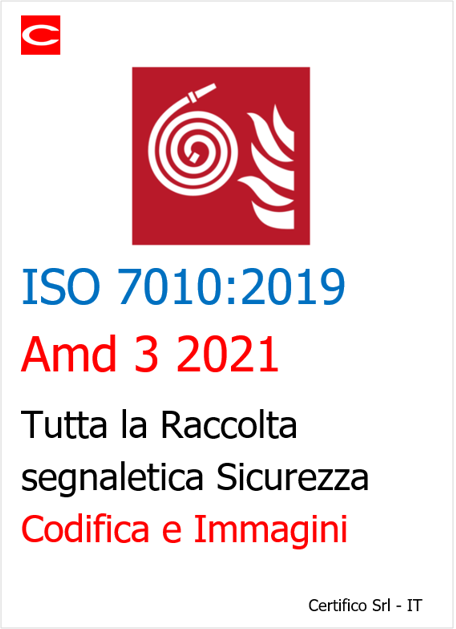
ISO 7010 Raccolta dei Segnali di sicurezza previsti dalla norma - Ed. 2021 Amd 3
Agosto 2021
Aggiornata la raccolta segnaletica ISO 7010:2019, con altri segnali pubblicati con l'emendamento 3 di luglio 2021:
- Raccolta immagini segnaletica Ed. 7.0 aggiornata con emendamento 3 di luglio 2021
Nuovi Pittogrammi Emendamento A3 Luglio 2021:
E067 - Evacuation mattress
E068 - Lifebuoy with light and smoke
E069 - Person overboard call point
F019 - Unconnected fire hose[/box-info]
ISO 7010:2019
Graphical symbols - Safety colours and safety signs - Registered safety signs
Corrigenda/Amendments:
ISO 7010:2011/Amd 1:2012
ISO 7010:2011/Amd 2:2012
ISO 7010:2011/Amd 3:2012
ISO 7010:2011/Amd 4:2013
ISO 7010:2011/Amd 5:2014
ISO 7010:2011/Amd 6:2014
ISO 7010:2011/Amd 7:2016
ISO 7010:2011/Amd 8:2017
ISO 7010:2011/Amd 9:2018
ISO 7010:2019/Amd 1:2020
ISO 7010:2019/Amd 2:2020
ISO 7010:2019/Amd 3:2021
- Published: 05 September 2021
- Hits: 25370
Posted in News
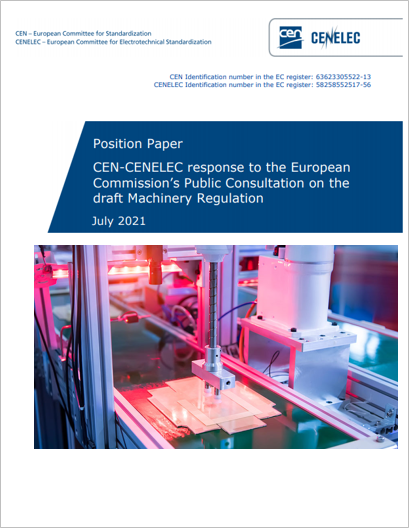
Position Paper CEN-CENELEC draft Machinery Regulation July 2021
ID 13933 | 07.07.2021 / In allegato Position paper
Position Paper CEN-CENELEC response to the European Commission’s Public Consultation on the draft Machinery Regulation July 2021
Il 21 aprile 2021, la Commissione Europea (CE) ha adottato la sua proposta di Regolamento Macchine che sostituirà la Direttiva Macchine 2006/42/CE.
Allo stesso tempo, la CE ha avviato una consultazione pubblica per ottenere un feedback sul progetto di regolamento macchine. Con questo documento, CEN e CENELEC forniscono la loro posizione su questa proposta.
Maggiori info
- Published: 07 July 2021
- Hits: 19645
Posted in News

CEM4 June 2021 Update
18 June 2021
CEM4 2a Version 2021 (156a 2004/2021)
- Published: 18 June 2021
- Hits: 21253
Posted in News
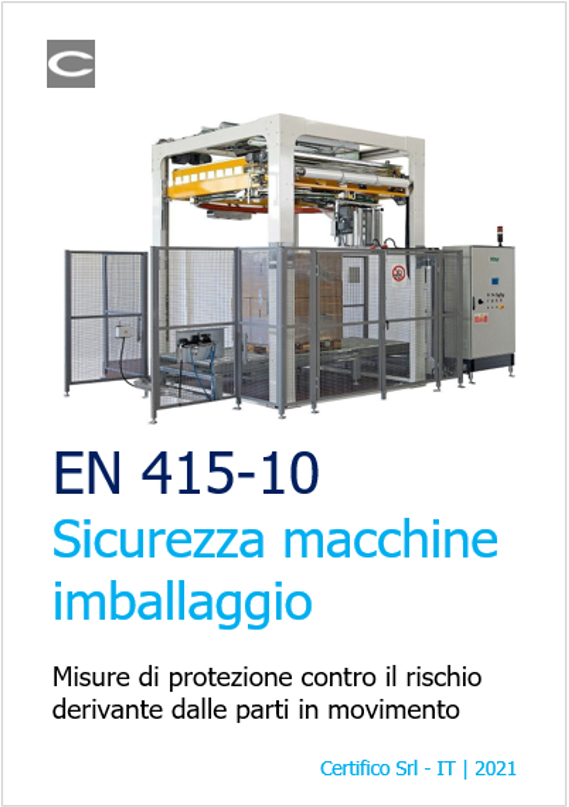
Sicurezza macchine per imballare EN 415-10
ID 3486 | Rev. 1.0 dell'8.05.2021 / Documento completo allegato
Le misure di protezione contro il rischio derivante dalle parti in movimento delle macchine per imballare in accordo con le norme della serie EN 415-X.
Il Documento, estratto dalla norma armonizzata EN 415-10:2014 Sicurezza delle macchine per imballare Parte 10: Requisiti generali, prende in esame la parte relativa alle misure di protezione contro il rischio derivante dalle parti in movimento.
Il Cap. 4 della EN 415-10 tratta dei pericoli di natura meccanica derivanti dalle parti in movimento (schiacciamento, cesoiamento, taglio, impigliamento, attrito, urto, trascinamento e intrappolamento. Non tutti questi pericoli possono essere eliminati solo tramite l’interruzione dell’alimentazione a causa della gravità o dell’energia accumulata.
Il Cap. 5.2.1 della EN 415-10, oggetto del Documento, analizza i pericoli derivanti dalle parti in movimento e le misure di protezione correlate.
La norma non analizza:
- il rischio derivante dall’utilizzo delle macchine in aree accessibili al pubblico;
- utilizzo della macchine per imballare in atmosfere potenzialmente esplosive;
- pericoli specifici per la salute, la sicurezza o l’igiene associati ai prodotti che possono essere manipolati dalle macchine, ma include consigli generali su tale argomento;
- pericoli che possono essere associati alla messa fuori servizio della macchine per imballare.
La norma tecnica EN 415-10 tratta dei requisiti generali per le macchine per imballare definite dalla EN 415-1 oppure oggetto di un’altra EN 415 specifica.
Norme della famiglia EN 415-X:
UNI EN 415-1:2014 - Sicurezza delle macchine per imballare - Parte 1: Terminologia e classificazione delle macchine per imballare e delle relative attrezzature;
UNI EN 415-2:2001 - Sicurezza delle macchine per imballare - Macchinario per imballare in contenitori preformati rigidi;
UNI EN 415-3:2010 - Sicurezza delle macchine per imballare - Parte 3: Formatrici, riempitrici e sigillatrici;
UNI EN 415-4:1998 - Sicurezza delle macchine per imballare - Pallettizzatori e depallettizzatori EC 1-2006 UNI EN 415-4:1998 - Sicurezza delle macchine per imballare - Pallettizzatori e depallettizzatori;
UNI EN 415-5:2010 - Sicurezza delle macchine per imballare - Parte 5: Macchine avvolgitrici;
UNI EN 415-6:2013 - Sicurezza delle macchine per imballare - Parte 6: Macchine avvolgitrici di pallet;
UNI EN 415-7:2008 - Sicurezza delle macchine per imballare - Parte 7: Macchine per imballaggi multipli;
UNI EN 415-8:2008 - Sicurezza delle macchine per imballare - Parte 8: Macchine reggiatrici;
UNI EN 415-9:2010 - Sicurezza delle macchine per imballare - Parte 9: Metodi di misurazione del rumore per macchine per imballare, linee d imballaggio e relative attrezzature, grado di accuratezza 2 e 3;
UNI EN 415-10:2014 - Sicurezza delle macchine per imballare - Parte 10: Requisiti generali.
Per la trattazione completa dell’argomento è necessario consultare la norma tecnica EN 415-10.
La EN 415-10 è una norma tecnica di tipo C ed è armonizzata per la direttiva macchine 2006/42/CE.
Maggiori Info
- Published: 11 June 2021
- Hits: 15218


































